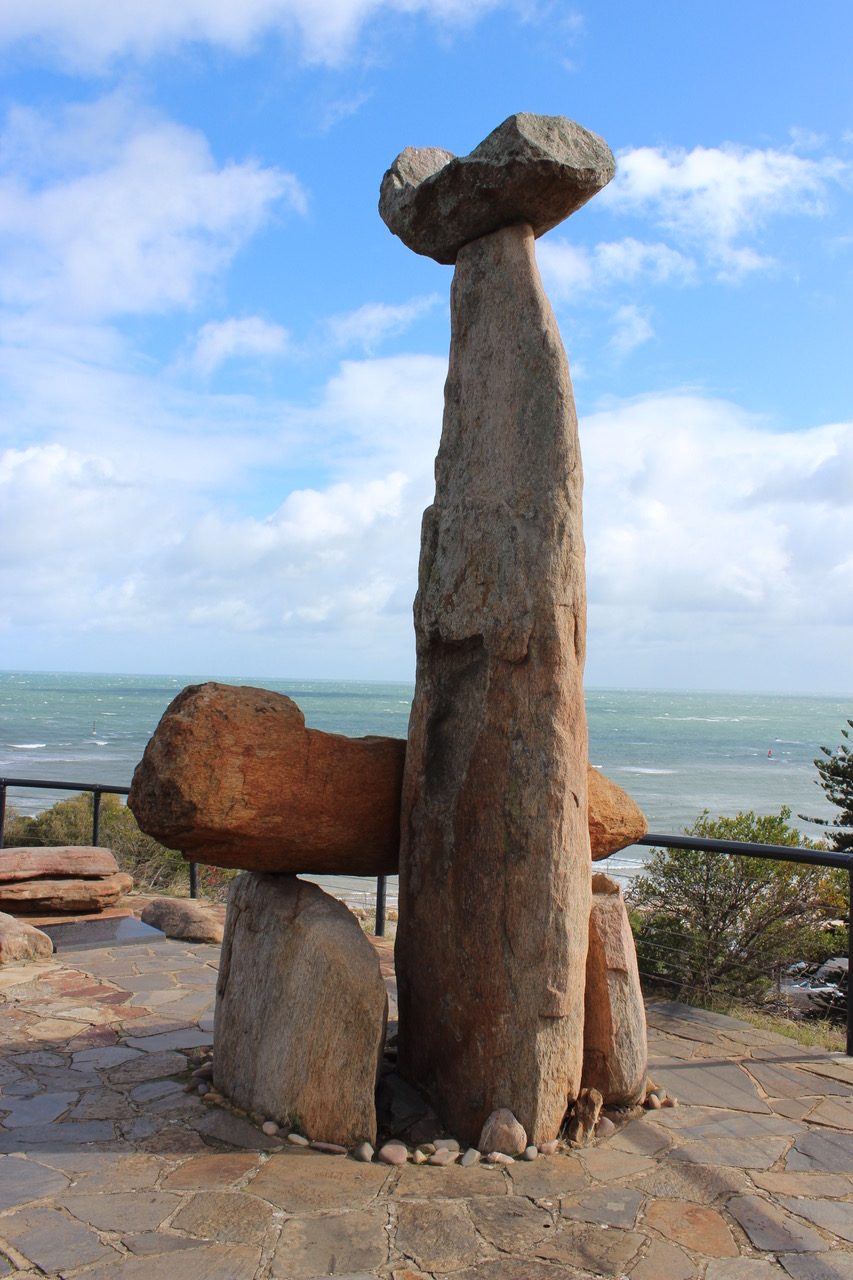The state government has been working since the early 1990s with six local councils to create a Coast Park Path, a 70 kilometre walking and cycling path along the metropolitan coast line, from North Haven to Sellicks Beach. There’s quite a bit of public art already installed along the Trail. Trends are revealing.
The Holdfast Bay Council has been the heavy lifter, accounting for the majority of the 20-plus works I could identify on the metropolitan Coast Trail. With a few exceptions, Holdfast Bay has purchased their selection from a series of Brighton Jetty Classic Sculpture events.
There have been some cross-agency collaborations. Contemplation, a multi-unit installation by Marijana Tadic at Marino is identified as a cultural development initiative created through the Marion Coast Interpretive Project and is a City of Marion project, assisted by the state government and related agencies. John Dowie’s Tjilbruke Monument on the hillside overlooking Seacliffwas funded by public subscription and developed under the sponsorship of the SA Museum and the Kaurna community. There are other examples.
The Marino to Glenelg strip is starting to fill up. North to Semaphore, Coastal Trail-sited works are few. Perhaps the community arts programs of Charles Sturt, West Torrens and Port Adelaide Enfield can learn lessons from their southern cousins in terms of what kind of legacy public art can bestow? The City of Charles Sturt has it nailed in its public art policy statement: “To create valued urban places that bring people together and reflect local character and identity.”
Other councils share similar objectives. Generally speaking, all have weighted their selections with an eye to specifics of place and a nod to history. Dowie’s Tjilbruke Monument is a clear example.
A lifesaver, Kathleen (Kitty) Whyte, is commemorated in Gerry McMahon’s quaint tribute at the entry to the Brighton Jetty. Indiana James’ White Bellied Sea Eagle near Henley Beach and Karl Meyer’s referencing of the same bird in Imprints of Time installation in the Minda coastal environment are clearly intended to direct viewers’ thoughts to the loss of habitat and species.
Greg Johns’ interlocking waveforms, Rhythm, at Glenelg make visual connections with the sea and the horizon while referencing in its switchback curves the fun-of-the-fair history of the Bay as a recreational destination.
 John Dowie, Tjilbruke Monument
John Dowie, Tjilbruke Monument
Assessing the quality of this very diverse collection of art is challenging. But the task is unavoidable for councils and arts agencies within them if they want the best for their communities and visitors. One successful strategy is the curated space in which art sits in partnership with all other elements – street furniture, lighting, landscaping, paving and so on.
Karl Meyer’s Imprints ‘pebbles’ work successfully within such an environment. Marijana Tadic’s Contemplation, a complex and elegant three-unit installation, is enhanced by considered landscaping and siting in relation to very rugged environs. Henley Square might be regarded as a total sculpture given that all components, such as the waveform benches and shell-like seats function successfully within an integrated visual environment.
The success of this approach exposes the conventional tactic of dotting stand-alone sculptures at intervals along the strip. Experienced, creative artists are up to this task because they are very aware of factors such as siting, scale, materiality and sightlines that can make the difference between ornamentation and public art that’s fit for site and purpose.
In this regard the Holdfast Bay strategy of sourcing most of its stand-alone works from the annual Brighton Jetty Classic Sculpture event has the potential to restrict the talent pool.
The event’s showcasing of sculpture – the exceptional, the OK and the give-it-a-go – is commendable to a point, but it lacks the selective rigour to stamp it as a serious player in a state that rates its festivals as top class. Why not adopt a two-tiered (curated and open sections) model, and build on its earlier success in attracting a cohort of innovative artists? The last event confirmed a rising tide of laser-cut steel, charm-bracelet ornamentation more suited to private gardens than exposed seashores. That said, some standalones (from Jetty events) have sculptural merit.
Chris Ormerod’s Shell evokes a sense of objects carried by tides and salvaged from seashores. Matthew Turley’s Gyre and Lindsay Butcher’s Life Support capture the energy of wind and flight. But, case in point, Gyre’s exposed siting is a shag on a rock resolution while Life Support’s proximity to two large trees amplifies its statement as a sculpture. Chris Murphy’s Hang Loose and Ty Manning’s Person Sitting on Bench (aka ‘Bench Man’) trade on some larrikin humour to earn their keep.
All cities, one arts writer has said, want an Angel of the North (referring to Antony Gormley’s landmark sculpture in north-east England). There’s no reason why Adelaide’s dress circle Coast Park Trail can’t aspire to an equivalent and exceptional public art experience.
The setting is awesome and the creative challenge equally so. But more pelicans, fish or dolphins rampant are not going to take us there.
John Neylon is an award-winning art critic and the author of several books on South Australian artists including Hans Heysen: Into The Light (2004), Aldo Iacobelli: I love painting (2006), and Robert Hannaford: Natural Eye (2007).
Get the latest from The Adelaide Review in your inbox
Get the latest from The Adelaide Review in your inbox